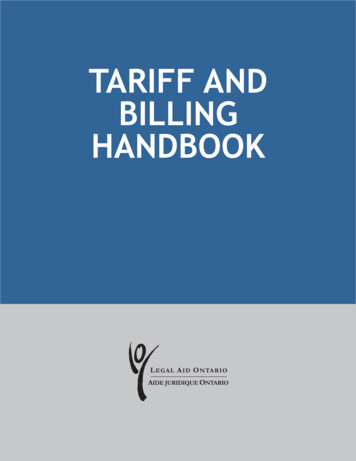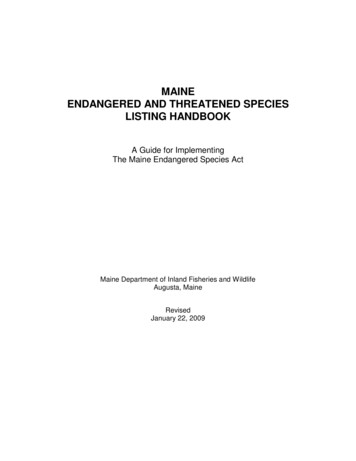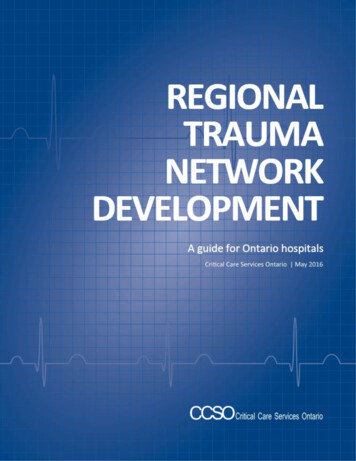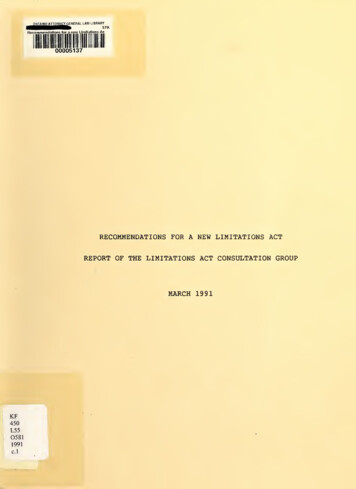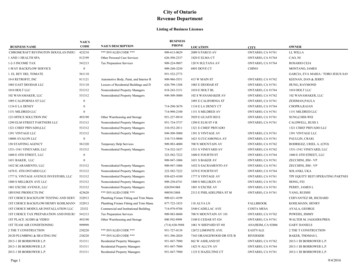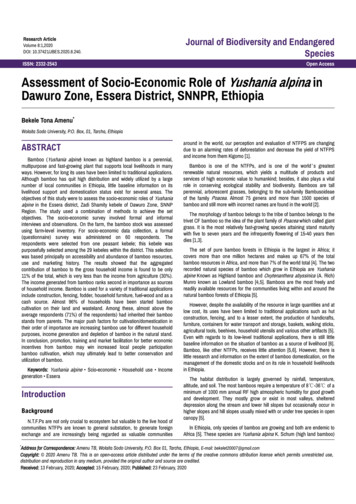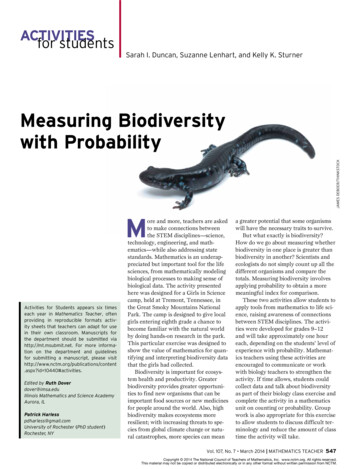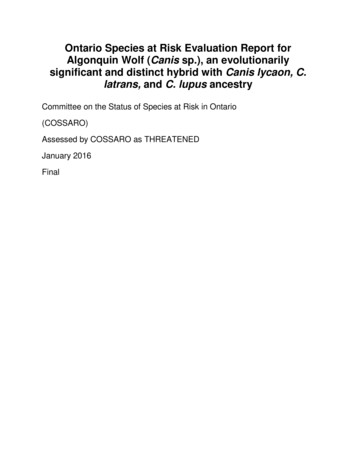
Transcription
Ontario Species at Risk Evaluation Report forAlgonquin Wolf (Canis sp.), an evolutionarilysignificant and distinct hybrid with Canis lycaon, C.latrans, and C. lupus ancestryCommittee on the Status of Species at Risk in Ontario(COSSARO)Assessed by COSSARO as THREATENEDJanuary 2016Final
Loup Algonquin (Canis sp.)Le loup Algonquin (Canis sp.) est un canidé de taille intermédiaire qui vit en meutefamiliale et qui se nourrit de proies comme le castor, le cerf de Virginie et l’orignal. Leloup Algonquin est le fruit d’une longue tradition d’hybridation et de rétrocroisemententre le loup de l’Est (Canis lycaon) (appelé aussi C. lupus lycaon), le loup gris (C.lupus) et le coyote (C. latrans). Bien qu’il fasse partie d’un complexe hybride répandu, leloup Algonquin peut se différencier des autres hybrides, comme le loup boréal desGrands Lacs, parce qu’il forme une grappe discrète, sur le plan génétique, composéed’individus étroitement apparentés à partir de laquelle il est possible de faire desestimations de filiation présumée. De plus, selon les données morphologiques, il estgénéralement plus grand que les canidés de type C. latrans et plus petit que lescanidés de type C. lupus, bien qu’une identification fiable nécessite des donnéesgénotypiques. En Ontario, le loup Algonquin est principalement confiné dans le parcprovincial Algonquin ainsi que dans les régions avoisinantes, dont certaines sontprotégées. Ces régions englobent le parc provincial Killarney au sud de la régioncaractéristique des Hautes-Terres de Kawartha. Les relevés plus éloignés sontrelativement rares et vraisemblablement attribuables à des incidents de dispersionoccasionnels sur de grandes distances. Comme le nombre total de canidés dans cegroupe génétique se chiffre probablement entre 250 et 1 000 individus matures, leloup Algonquin a été désigné comme une espèce menacée.Cette publication hautement spécialisée « Ontario Species at Risk evaluation reportprepared under the Endangered Species Act, 2007 by the Committee on the Status ofSpecies at Risk in Ontario », n'est disponible qu'en anglais conformément auRèglement 671/92, selon lequel il n’est pas obligatoire de la traduire en vertu de la Loisur les services en français. Pour obtenir des renseignements en français, veuillezcommuniquer avec le ministère des Richesses naturelles par courriel àrecovery.planning@ontario.ca.
Executive summaryThe Algonquin Wolf (Canis sp.) is an intermediate-sized canid that lives in family-basedpacks and feeds on prey that includes Beaver, White-tailed Deer, and Moose. TheAlgonquin Wolf is the result of a long history of hybridization and backcrossing amongEastern Wolf (Canis lycaon) (aka C. lupus lycaon), Gray Wolf (C. lupus), and Coyote (C.latrans). Although part of a widespread hybrid complex, the Algonquin Wolf can bedifferentiated from other hybrids, such as the Great Lakes-Boreal Wolf, because it formsa genetically discrete cluster of closely related individuals from which estimates ofinferred ancestry can be derived. In addition, morphological data identify it as beinggenerally larger than C. latrans-type canids, and smaller than C. lupus-type canids,although reliable identification requires genotypic data. The Algonquin Wolf is largelyrestricted in Ontario to Algonquin Provincial Park plus surrounding areas, some of whichare protected. These include an area from Killarney Provincial Park south to KawarthaHighlands Signature Site. More distant records are relatively infrequent and likelyattributable to occasional long-distance dispersal events, The total number of canids inthis genetic group likely numbers between 250 and 1000 mature individuals, andtherefore it has been designated as Threatened.
1. Background information1.1. Current designationsThe closest comparison is with Canis lupus lycaon or Canis sp. cf. lycaon, the currentdesignations of which are provided below: GRANK: G4G5TNR, Eastern Wolf (Canis lupus lycaon) (NatureServe 2015) COSEWIC: Threatened, Eastern Wolf (Canis sp. cf. lycaon) (COSEWIC 2015) SARA: Special Concern (Schedule 1), Eastern Wolf (Canis lupus lycaon) (SARA2015) ESA: Special Concern, Eastern Wolf (Canis lupus lycaon) (Ontario Regulation230/08 2015) SRANK: S4, Eastern Wolf (Canis lupus lycaon) (NatureServe 2015)1.2. Distribution in OntarioThe Algonquin Wolf is discontinuously distributed in the mixed Great Lakes-St.Lawrence Forest of central Ontario, and is concentrated in various protected areas(Figures 1 and 2). It occurs from Killarney Provincial Park east to Algonquin ProvincialPark (hereafter APP) and the Ottawa Valley, south to Fenelon Falls and Buckhorn, withrare records west to the Sault Ste. Marie area.1.3. Distribution and status outside OntarioOutside of Ontario the Algonquin Wolf (identified on the basis of 80% or higher inferredancestry with wolves in Algonquin Provincial Park; see Section 2) occurs primarily insouthern Quebec north of the St. Lawrence River (COSEWIC 2015). Researchers haveidentified a taxon as Eastern Wolf (Canis lycaon) in the western Great Lakes region ofthe USA (Mech 2010; Fain et al. 2010), but these populations are thought to beprimarily hybrids between Canis lupus and C. lycaon (aka C. lupus lycaon) (Wheeldonand White, 2009; Wheeldon et al. 2010a; Fain et al. 2010; Rutledge et al. 2015), andpopulation genetic comparisons between Algonquin and Great Lakes Wolves do notsuggest that the two groups share high recent ancestry (L. Rutledge, T. Wheeldon,pers. comm., 2015; Rutledge et al. 2015; although see vonHoldt et al. 2011; Rutledge etal. 2012; Monzon et al. 2014; Rutledge et al. 2015 for some of the complexitiessurrounding this issue). Mitochondrial and Y chromosome haplotypes that have beenassociated with C. lycaon have been found as far west as Saskatchewan, as far east asQuebec, and across broad regions of the northeastern United States (Wilson et al.2000; Grewal et al. 2004; Koblmüller et al. 2009; Fain et al. 2010; Stronen et al. 2010,2012; Way et al. 2010), but these likely represent historical hybridization events, and thedescendants of these hybrids are not closely related to the Algonquin Wolves.
Figure 1. Distribution of recent Algonquin Wolf records in Ontario.
Figure 2. Area from which EOO was calculated as 79,710 km2 (source:NHIC).1.4. Ontario conservation responsibilityOntario represents the majority of the global range of Algonquin Wolf, withapproximately 63% of the extent of occurrence (EOO) in Ontario. Ontario representsapproximately 65% of the population of mature individuals estimated by COSEWIC(Table 2; 2015).1.5. Direct threatsAlthough human-caused mortality is identified as a significant threat, a reduction inhunting and trapping mortality from 67% to 16% resulting from a ban in townships inand adjacent to Algonquin Park in 2001 was followed by a comparable increase innatural mortality rates (COSEWIC 2015). Although the provincial government iscurrently proposing to loosen restrictions governing the hunting of coyotes in northernOntario (north of wildlife management unit 42), nothing is proposed to change in orsouth of wildlife management unit 42 (Killarny-Sudbury-North Bay). There are areas insouthern and central Ontario which currently house some Algonquin Wolves and whereneither wolves nor coyotes are protected from hunting, but that has been the case formore than a decade, and in these areas hunting and trapping remain a significantthreat. However, although there is a threat from hunting and trapping to AlgonquinWolves in some areas this threat is not increasing, other than for those few animalsnorth of the continuous distribution in areas like Sault Ste. Marie (B. Patterson, pers.comm., 2016). Rabies and mange have been significant mortality factors on occasion,but are not consistent threats.The Threats Calculator in COSEWIC (2015) indicated that high threats are hunting andtrapping, associated with high road densities that facilitate human access. Medium
threats include road-related mortality. Residential housing development is considered alow threat, related more to a potential increase in human-related mortality than toquantitative habitat loss (COSEWIC 2015).1.6. Specialized life history or habitat use characteristicsThe Algonquin Wolf is not restricted to any specific habitat type, although it is mostabundant in areas with abundant prey such as Moose (Alces alces), White-tailed Deer(Odocoileus virgianus) and Beaver (Castor canadensis), and low levels of humancaused mortality (COSEWIC 2015). Den and rendezvous sites are typically located inconifer-dominated landscapes near a permanent water source with suitable soil such assand for excavation (COSEWIC 2015).2. Eligibility for Ontario status assessment2.1. Eligibility conditions2.1.1. Taxonomic distinctnessYes. The wolves from Algonquin Provincial Park have previously been identified asEastern Wolves (Rutledge et al. 2010a; Benson et al. 2012; COSEWIC 2015), which inturn have been identified as either Canis lycaon (Rutledge et al. 2010a; Benson et al.2012), Canis sp. cf. lycaon (COSEWIC 2015), or Canis lupus lycaon (Van Zyll de Jongand Carbyn 1999). Much of the debate about the taxonomy of Canis is associated withthe arrival of the Coyote (Canis latrans) into eastern North America. In a continentalscale invasion, Coyotes from the Prairie region of North America expanded northwardand eastward; the first record in southeastern Ontario was in 1919 (Nowak 1979).These small Canis (e.g., adult male averages of 13 - 14 kg in different parts of thecentral Prairies [Parker 1995]) bred with a larger Canis in the Great Lakes region andproduced an intermediate-sized animal (e.g., adult male averages of 14.6 - 21 kg indifferent parts of northeastern North America [Parker 1995; Villemure and Jolicoeur2004]). The new animal, named the Eastern Coyote, then established itself acrosseastern Canada, reaching Québec in 1944, Nova Scotia in the 1970s, andNewfoundland in 1985 (Parker 1995; Naughton 2012).There is general consensus that the historical and continued sympatric distributions ofC. lycaon, C. lupus, and C. latrans has led to widespread and longstandinghybridization, backcrossing, advanced-generation hybridization, and introgressionamong these three taxa in eastern North America (Grewal et al. 2004; Rutledge et al.2010a; Way et al. 2010; Wheeldon et al. 2010b; Wilson et al. 2012; Benson et al. 2012;Rutledge et al. 2012), and this introgression may also have involved genes fromdomestic dogs (C. lupus familiaris) (Wilson et al. 2012; Wheeldon et al. 2013; Monsonet al. 2014). This explains some of the confusion regarding the identity and distributionof Algonquin Wolves (see Section 1.3).Morphological data provide a potential method for identifying putative AlgonquinWolves, as there are numerous records of canids in Ontario that are intermediate in size
to Gray Wolves and Coyotes (e.g. Kolenosy and Standfield 1975; Theberge andTheberge 2004; Rutledge et al. 2010b; Benson et al. 2012). The Algonquin Wolfphenotype is a continuum of sizes that are generally intermediate to C. lupus and C.latrans (Benson et al. 2012), and this intermediate size range has been attributed tohybridization between Gray Wolves and Coyotes (Nowak 1979, 1995), or a response tochanges in prey size (Young and Goldman 1944; Kolenosky and Standfield 1975;Schmitz and Kolenosky 1985; Brewster and Fritts 1995; Nowak 1995). The hybridwolves of APP are overall intermediate in size to C. lupus-like canids and C. latrans-likecanids, typically weighing 30 kg (Theberge and Theberge 2004). Based on datacollected in Algonquin Park from 2002 - 2007, female average yearling weight is 18.1 kgand female average adult weight is 24.2 kg, whereas male average yearling weight is23.5 kg and average adult weight is 29.3 kg (COSEWIC, 2015). Average adult shoulderheight for Algonquin Wolves is 63.8 cm for females and 70.0 cm for males (BrentPatterson pers. comm. cited in COSEWIC [2015]). However, size ranges do have someoverlap between Algonquin Wolves, C. latrans-like canids, and C. lupus-like canids (B.Patterson, pers. comm. 2015), and therefore size is not a completely reliable identifier.To date, the most definitive assignments of individuals to the Algonquin Wolf populationhave been based on population genetic data. Researchers have used these data,typically microsatellite allele and genotype frequencies, combined with programs suchas Structure (Pritchard et al. 2000; Falush et al., 2003; Hubisz et al. 2009), to firstidentify the most plausible number of genetic clusters within any given data set; in thiscontext, clusters represent groups of potentially interbreeding individuals that eachconform to parameters such as Hardy-Weinberg equilibrium and linkage equilibrium.Once such clusters have been identified, membership to each cluster can be estimatedby inferred ancestry to each cluster. COSEWIC (2015) used an inferred ancestrycoefficient (Q) of 0.8 or higher as the threshold for identifying animals as EasternWolves, but which we are here referring to as Algonquin Wolves. There is no known‘pure’ Eastern Wolf individual or population that can be used as a genetic reference,and it is therefore most accurate to say that the Q value of 0.8 or higher can be used toidentify wolves with a high level of inferred ancestry to the Algonquin Wolf population.Indeed, the COSEWIC report (2015) acknowledges that ‘ we lack enough specimensthat have been collected before Coyotes were present to characterize a pure EasternWolf’. This lack of reference material, combined with a well-documented pattern ofhybridization, admixture, and introgression among Ontario canids (see above), meansthat the Algonquin Wolf is most appropriately described as a hybrid group thatcollectively represents a genetically discrete cluster with distinct morphologicalcharacteristics. For this assessment, we therefore considered individuals with aninferred ancestry of 0.8 or higher (following Structure analyses) to the APP wolves tobelong to the genetic cluster that largely inhabits APP, in other words we consideredthose individuals to be Algonquin Wolves.Geneclass (Piry et al. 2004) assignment tests supplemented the Structure analyses byusing the Algonquin reference population of 88 canids with Q 0.8 (based on Structure;Rutledge et al. [2010]) to determine whether or not canids from an additional 105individuals sampled from outside APP were assigned to the APP population. Nineteenindividuals from outside the park were assigned to the APP population by Geneclass,whereas 33 individuals from the same group were identified by Structure as having an
inferred ancestry of 0.8 or greater with the APP population (T. Wheeldon, L. Rutledge,B. Patterson, unpublished data). This discrepancy had a negligible impact on both theextent and the area of occurrence of Algonquin wolves, and although it did reduce by 14the number of wolves outside APP identified as having high ancestry with the AlgonquinWolf, the uncertainty in total population size associated with incomplete samplingoutside APP means that the difference in inferred numbers of Algonquin wolves outsidethe park based on the two methods of analysis (Structure versus Geneclass) is unlikelyto have an appreciable impact on estimates of total population size. Because bothmethods (Structure and Geneclass) are model-based, both carry sets of assumptions,and should be viewed as complementary analytical approaches. In this case, theoutcomes from each type of model were of sufficient similarity to strengthen our overallconclusions regarding distribution and population size.Finally, an unpublished study found that some alleles in the major-histocompatibilitycomplex (MHC), a group of genes involved in immune response, were found inAlgonquin Wolves but not in either Eastern Coyotes or Grey Wolves (Kennedy pers.comm. to L. Rutledge, 2012). Although preliminary, these data further reinforce theconclusion that the Algonquin Wolf comprises an evolutionarily distinct unit.Collectively, the data outlined above support the premise that the Algonquin Wolfconforms to the broad definition of species defined by Endangered Species Act, 2007(ESA), which states that “species” means a species, subspecies, variety or geneticallyor geographically distinct population of animal, plant or other organism, other than abacterium or virus, that is native to Ontario”. Following this definition, the geneticdistinctness of the Algonquin Wolf, combined with its native status, makes it suitable forOntario status assessment. COSSARO has named this taxon Algonquin Wolf (Canissp.) to a) differentiate it from other populations that have been labelled ‘Eastern Wolf’(e.g. hybrids in the Great Lakes region, which are genetically distinct from the AlgonquinWolf; L. Rutledge and T. Wheeldon, pers. comm.), and b) acknowledge the hybridancestry of this evolutionarily significant unit. Although COSSARO has chosen to use adifferent name than COSEWIC has used (Eastern Wolf), these two taxa are consideredto have the same genetic characteristics.2.1.2. Designatable unitsNo. There is a single genetic cluster to which the majority of APP canids are assignedat an inferred ancestry of 0.8 or higher.2.1.3. Native statusYes. The Algonquin Wolf shares ancestry with C. lycaon, which is native to Ontario, withrecords dating back to the 1700s (COSEWIC 2015). The long-term presence of anintermediate-sized canid in eastern Canada is also confirmed by Aboriginal TraditionalKnowledge. Gray Wolves are also considered native to Ontario, and Eastern Coyoteshave been in Ontario for at least 100 years. Therefore, all of the taxa within this hybridcomplex are native to Ontario.
2.1.4. OccurrenceThe current Ontario distribution of the Algonquin Wolf is in central Ontario, with coreconcentrations in APP and surrounding townships (Figure 1). The Algonquin Wolf alsooccurs in and around Killarney Provincial Park, Kawartha Highlands Signature Site,Queen Elizabeth II Wildlands, and the Magnetawan area (Rutledge et al. 2010a;Benson et al. 2012; Wilson et al. 2009; B. Patterson, pers. comm.). In addition, thereare a few records from Manitoulin Island and the area around Sault Ste. Marie. Thisdistribution is based on genetic analysis (Structure) of 154 individuals as mapped inCOSEWIC (2015) and six additional analyzed records from the Natural HeritageInformation Centre.2.2. Eligibility resultsAlgonquin Wolf is eligible for status assessment in Ontario.3. Ontario status assessment3.1. Application of endangered/threatened status in Ontario3.1.1. Criterion A – Decline in total number of mature individualsDoes not apply/insufficient information. The Algonquin Wolf population appears to bestable (COSEWIC 2015).3.1.2. Criterion B – Small distribution range and decline or fluctuationDoes not apply. Exceeds thresholds for EOO (79710 km2) and IAO ( 10000 km2).3.1.3. Criterion C – Small and declining number of mature individualsDoes not apply. No evidence of a population decline.3.1.4. Criterion D – Very small or restricted total populationThreatened. The Algonquin Wolf meets D1 because the estimated population of matureindividuals is less than 1000. COSEWIC (2015) estimated that the minimum number ofmature individuals in Ontario is 154, and the estimated maximum number of AlgonquinWolves inferred from sampled sites in Ontario is 488. However, under-sampling in someareas, e.g. between Georgian Bay and APP (L. Rutledge, pers. comm. 2015), combinedwith the need to genotype individuals in order to identify Algonquin Wolves, has almostcertainly led to an underestimation of the Algonquin Wolf population size, and the actualnumber is most likely somewhere between 250 and 1000.3.1.5. Criterion E – Quantitative analysisDoes not apply/inconclusive. Reanalysis of a PVA which predicted extirpation of APP
wolves (Theberge et al. 2006) concluded that wolves in APP are unlikely to declinesignificantly over the next 20 years (Patterson and Murray, 2008).3.2. Application of Special Concern in OntarioNot applicable.3.3. Status category modifiers3.3.1. Ontario’s conservation responsibilityOntario represents much greater than 25% of the global range of Eastern Wolf asdescribed in COSEWIC (2015), and thus this status modifier could potentially apply. .3.3.2. Rescue effectRescue effect is unlikely because individuals from geographically distant locations areunlikely to genetically cluster with APP wolves. Some rescue effect from Quebecpopulations may be feasible, although risks of human-caused mortality andhybridization with coyotes increase outside of protected areas.3.4. Other status categories3.4.1. Data deficientDoes not apply.3.4.2. Extinct or extirpatedDoes not apply.3.4.3. Not at riskDoes not apply.
4. Summary of Ontario statusThe Algonquin Wolf, a hybrid with Canis lycaon, C. latrans, and C. lupus ancestry, isclassified as Threatened in Ontario under criterion D1.5. Information sourcesBenson J.F., Patterson B.R. and T.J. Wheeldon. 2012. Spatial genetic and morphologicstructure of wolves and coyotes in relation to environmental heterogeneity in a Canishybrid zone. Molecular Ecology 21: 5934–5954.Brewster W.G. and S.H. Fritts. 1995. Taxonomy and genetics of the gray wolf inwestern North America: a review. In: Ecology and Conservation of Wolves in aChanging World (eds. Carbyn LN. et al.), pp. 353–374. Canadian Circumpolar Institute,Edmonton, Alberta, Canada.COSEWIC. 2015. COSEWIC assessment and status report on the Eastern Wolf Canissp. cf. lycaon in Canada. Committee on the Status of Endangered Wildlife in Canada.Ottawa. xii 67 pp.Endangered Species Act, 2007, S.O. 2007, c. 6 - Bill 184.Fain, S.R., Straughan, D.J., and B.F. Taylor. 2010. Genetic outcomes of wolf recoveryin the western Great Lakes states. Conservation Genetics 11: 1747-1765.Falush D, Stephens M, and J.K. Pritchard. 2003. Inference of population structure usingmultilocus genotype data: linked loci and correlated allele frequencies. Genetics.164:1567–1587.Grewal, S.K., Wilson, P.J., Kung, T.K., Shami, K., Theberge, M.T., Theberge, J.B., andB.N. White. 2004. A genetic assessment of the eastern wolf (Canis lycaon) in AlgonquinProvincial Park. Journal of Mammalogy 85:625-632.Hubisz MJ, Falush D, Stephens M, and J.K. Pritchard. 2009. Inferring weak populationstructure with the assistance of sample group information. Molecular EcologyResources. 9:1322–133.Kennedy, L.J. pers. comm. 2012. Email correspondence to L Rutledge January 9,2012.Senior Scientist, University of Manchester, Centre for Integrated Genomic MedicalResearch, Manchester, United Kingdom.Koblmüller, S., Nord, M., Wayne, R.K., and J.A. Leonard. 2009. Origin and status of theGreat Lakes wolf. Molecular Ecology. 11: 2313-2326.Kolenosky, G., and R. Standfield. 1975. Morphological and ecological variation amongGray wolves (Canis lupus) of Ontario, Canada. Pp 62-72. in M. Fox (ed.). The WildCanids. Van Nostrand Reinhold: New York.Rutledge L.Y., White B.N., Row J.R., and B.R. Patterson. 2012. Intense harvesting of
eastern wolves facilitated hybridization with coyotes. Ecology and Evolution 2 (1): 19–33Mech, L. D. 2010. What is the taxonomic identity of Minnesota Wolves? CanadianJournal of Zoology. 88: 129-138.Monzón, J., Kays, R., and D.E. Dykhuizen., 2014. Assessment of coyote-wolf-dogadmixture using ancestry-informative diagnosticSNPs. Molecular Ecology 23: 182–197.NatureServe 2015. Canis lupus lycaon - Schreber, 1775. Eastern Wolf. [websiteaccessed December 2, 2015].Naughton, D. 2012. The Natural History of Canadian Mammals. University of TorontoPress, Toronto, ON. 784 pp.Nowak, R.M. 1979. North American Quaternary Canis. Museum of Natural History,University of Kansas (Monograph No. 6), Lawrence, Kansas.Nowak, R.M. 1995. Another look at wolf taxonomy. Pp. 375-398, in L.N. Carbyn, S.H.Fritts and D.R. Seip (eds.). Ecology and Conservation of Wolves in a Changing World.Canadian Circumpolar Institute, Occasional Publication No. 35, 642 pp.Parker, G. 1995. Eastern Coyote: The Story of its Success. Nimbus Publishing, Halifax,NS. 254 pp.Patterson, B.R., and D.L. Murray. 2008. Flawed population viability analysis can resultin misleading population assessment: a case study for wolves in Algonquin Park,Canada. Biological Conservation 141:669-680.Patterson, B.R. pers. comm. 2016. Email to Joanna Freeland, January, 2016.Piry, S., Alapetite, A., Cornuet, J.-M., Paetkau, D., Baudouin, L., and A. Estoup. 2004.GENECLASS2: A Software for Genetic Assignment and First-Generation MigrantDetection. Journal of Heredity 95:536-539.Pritchard J.K., Stephens M., and P. Donnelly. Inference of population structure usingmultilocus genotype data. Genetics. 2000;155:945–959.Rutledge L.Y., Garroway, C.J., Loveless, K.M., and B.R. Patterson. 2010a. Geneticdifferentiation of eastern wolves in Algonquin Park despite bridging gene flow betweencoyotes and Gray wolves. Heredity 105: 520-531.Rutledge L.Y. 2010. Evolutionary origins, social structure, and hybridisation of theeastern wolf (Canis lycaon). Ph.D. dissertation, Trent University, Peterborough, Ontario,Canada. 187 pp.Rutledge, L.Y., P.J. Wilson, C.F.C. Klütsch, B.R. Patterson and B.N. White. 2012.Conservation genomics in perspective: a holistic approach to understanding Canisevolution in North America. Biological Conservation 155: 186-192.
Rutledge L.Y. pers. comm. 2015. Telephone conversation to Joanna Freeland,December, 2015.Rutledge, L.Y., Devillard, S., Boone, J.Q., Hohenlohe, P.A., B.N. White. RADsequencing and genomic simulations resolve hybrid origins within North AmericanCanis. Biology Letters 11: 20150303Species at Risk Act (SARA). 2015. [website accessed on December 2, 2015].Stronen, A.V. (and 9 co-authors). 2012. Canid hybridization: contemporary evolution inhuman-modified landscapes. Ecology and Evolution 2: 2128-2140.Stronen, A.V., Forbes G.J., Sallows T., Goulet G., Musiani M., and P.C. Paquet. 2010.Wolf body mass, skull morphology, and mitochondrial DNA haplotypes in the RidingMountain National Park region of Manitoba, Canada. Canadian Journal of Zoology 88:496-507.Theberge, J. and M. Theberge. 2004. The Wolves of Algonquin Park: A 12-YearEcological Study. Publication Series Number 56, Department of Geography, Universityof Waterloo, Waterloo, Canada.Theberge J.B., Theberge M.T., Vucetich J.A., and P.C. Paquet . 2006. Pitfalls ofapplying adaptive management to a wolf population in Algonquin Provincial Park,Ontario. Environmental Management 37: 451–460.Van Zyll de Jong, C.G., and L. Carbyn. 1999. COSEWIC Status Report on the GrayWolf (Canis lupus) in Canada. Committee on the Status of Endangered Wildlife inCanada. Ottawa. 61 pp.Villemure, M., and H. Jolicoeur. 2004. First confirmed occurrence of a wolf, Canis lupus,south of the St. Lawrence River in over 100 years. Canadian Field-Naturalist 118: 608610.vonHoldt, B.M., and 18 others. 2011. A genome-wide perspective on the evolutionaryhistory of enigmatic wolf-like canids. Genome Research 21:1294-1305.Way J.G., Rutledge L., Wheeldon T., and B.N. White. 2010. Genetic characterization ofeastern “coyotes” in eastern Massachusetts. Northeastern Naturalist 17: 189–204.Wheeldon, T., and B.N. White. 2009. Genetic analysis of historic western Great Lakesregion wolf samples reveals early Canis lupus/lycaon hybridization. Biology Letters5:101–104.Wheeldon, T.J., Patterson, B.R., B.N. White. 2010a. Sympatric wolf and coyotepopulations of the western Great Lakes region are reproductively isolated. MolecularEcology 19:4428-4440.Wheeldon T., Patterson B., and B. White. 2010b. Colonization history and ancestry ofnortheastern coyotes. Biology Letters 6: 246–247.
Wheeldon T., Rutledge L., Patterson B., White B., Wilson P. 2013. Y-chromosomeevidence supports asymmetric dog introgression into eastern coyotes. Ecology andEvolution 3: 3005-3020.Wheeldon, T. pers. comm. 2015. Email to Joanna Freeland, November 19th, 2015.Wilson P.J., Rutledge L.Y., Wheeldon T.J., Patterson B.R., and B.N. White 2012. Ychromosome evidence supports widespread signatures of three-species Canishybridization in eastern North America. Ecology and Evolution 2: 2325–2332Wilson P.J., (and 14 co-authors). 2000. DNA profiles of the eastern Canadian wolf andthe red wolf provide evidence for a common evolutionary history independent of theGray wolf. Canadian Journal of Zoology 78: 2156-2166.Young S. and E. Goldman. 1944. The Wolves of North America. Dover Publications,New York, NY. 636 pp.
Appendix 1: Technical summary for OntarioSpecies: Algonquin Wolf (Canis sp.)Demographic informationDemographic attributeValueGeneration time.Based on average age of breeding adult: age at firstbreeding X year; average life span Y years.Is there an observed, inferred, or projected continuingdecline in number of mature individuals?Estimated percent of continuing decline in total numberof mature individuals within 5 years or 2 generations.Observed, estimated, inferred, or suspected percentreduction or increase in total number of matureindividuals over the last 10 years or 3 generations.Projected or suspected percent reduction or increase intotal number of mature individuals over the next 10years or 3 generations.Observed, estimated, inferred, or suspected percentreduction or increase in total number of matureindividuals over any 10 years, or 3 generations, over atime period including both the past and the future.Are the causes of the decline a. clearly reversible and b.understood and c. ceased?3.5 yearsAre there extreme fluctuations in number of nknowna. Unknownb. Yesc. PossiblyExtent and occupancy information in OntarioExtent and occupancy attributesEstimated extent of occurrence.(Request value from MNRF or usehttp://geocat.kew.org/)Index of area of occupancy (IAO).(Request value from MNRF or usehttp://geocat.kew.org/)Is the total population severely fragmented?(i.e. is 50% of its total area of occupancy is in habitatpatches that are (a) smal
collected in Algonquin Park from 2002 - 2007, female average yearling weight is 18.1 kg and female average adult weight is 24.2 kg, whereas male average yearling weight is 23.5 kg and average adult weight is 29.3 kg (COSEWIC, 2015). Average adult shoulder height for Algonquin W olves is 63.8 cm for females and 70.0 cm for males (Brent
